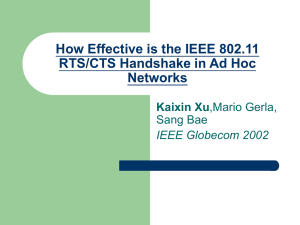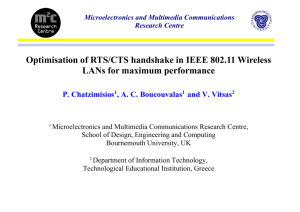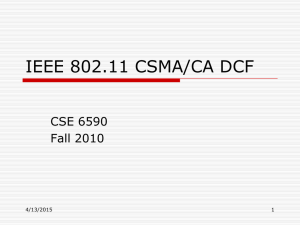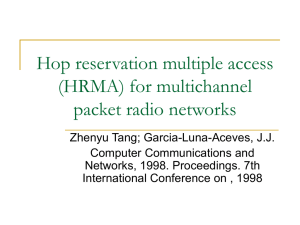On the Performance Behavior of IEEE 802.11 Distributed
advertisement
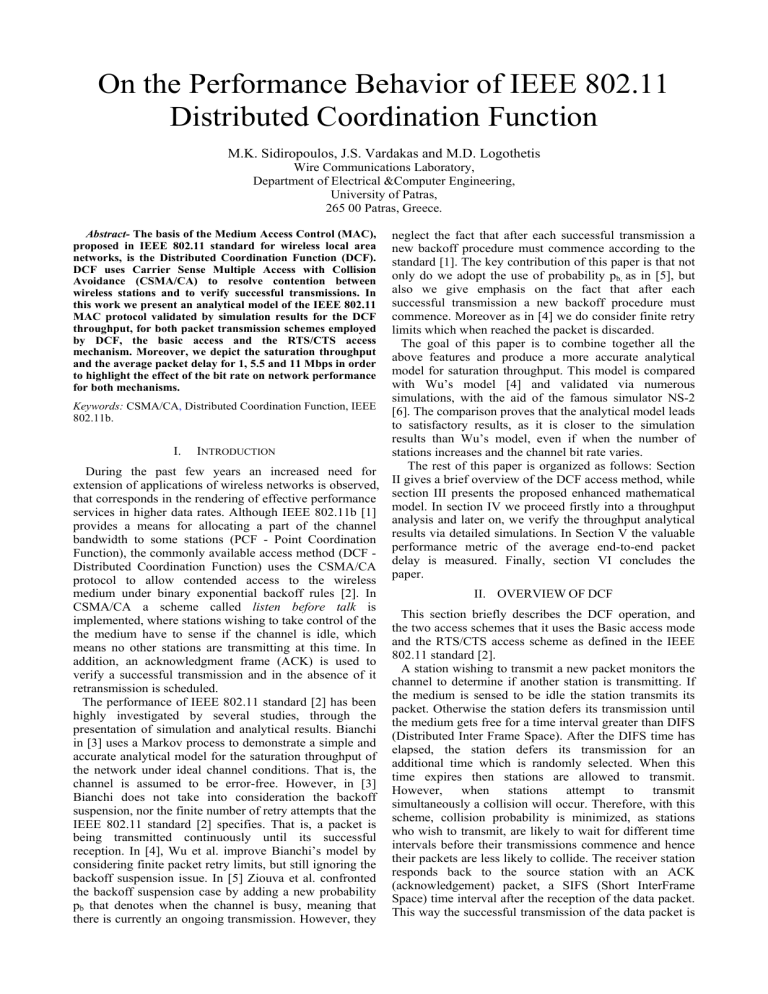
On the Performance Behavior of IEEE 802.11
Distributed Coordination Function
M.K. Sidiropoulos, J.S. Vardakas and M.D. Logothetis
Wire Communications Laboratory,
Department of Electrical &Computer Engineering,
University of Patras,
265 00 Patras, Greece.
neglect the fact that after each successful transmission a
new backoff procedure must commence according to the
standard [1]. The key contribution of this paper is that not
only do we adopt the use of probability pb, as in [5], but
also we give emphasis on the fact that after each
successful transmission a new backoff procedure must
commence. Moreover as in [4] we do consider finite retry
limits which when reached the packet is discarded.
The goal of this paper is to combine together all the
above features and produce a more accurate analytical
model for saturation throughput. This model is compared
with Wu’s model [4] and validated via numerous
simulations, with the aid of the famous simulator NS-2
Keywords: CSMA/CA, Distributed Coordination Function, IEEE
[6]. The comparison proves that the analytical model leads
802.11b.
to satisfactory results, as it is closer to the simulation
results than Wu’s model, even if when the number of
I. INTRODUCTION
stations increases and the channel bit rate varies.
The rest of this paper is organized as follows: Section
During the past few years an increased need for
II
gives
a brief overview of the DCF access method, while
extension of applications of wireless networks is observed,
section
III
presents the proposed enhanced mathematical
that corresponds in the rendering of effective performance
model.
In
section
IV we proceed firstly into a throughput
services in higher data rates. Although IEEE 802.11b [1]
analysis
and
later
on, we verify the throughput analytical
provides a means for allocating a part of the channel
results
via
detailed
simulations. In Section V the valuable
bandwidth to some stations (PCF - Point Coordination
performance
metric
of the average end-to-end packet
Function), the commonly available access method (DCF delay
is
measured.
Finally,
section VI concludes the
Distributed Coordination Function) uses the CSMA/CA
paper.
protocol to allow contended access to the wireless
medium under binary exponential backoff rules [2]. In
II. OVERVIEW OF DCF
CSMA/CA a scheme called listen before talk is
This section briefly describes the DCF operation, and
implemented, where stations wishing to take control of the
the two access schemes that it uses the Basic access mode
the medium have to sense if the channel is idle, which
and the RTS/CTS access scheme as defined in the IEEE
means no other stations are transmitting at this time. In
802.11 standard [2].
addition, an acknowledgment frame (ACK) is used to
A station wishing to transmit a new packet monitors the
verify a successful transmission and in the absence of it
channel to determine if another station is transmitting. If
retransmission is scheduled.
the medium is sensed to be idle the station transmits its
The performance of IEEE 802.11 standard [2] has been
packet. Otherwise the station defers its transmission until
highly investigated by several studies, through the
the medium gets free for a time interval greater than DIFS
presentation of simulation and analytical results. Bianchi
(Distributed Inter Frame Space). After the DIFS time has
in [3] uses a Markov process to demonstrate a simple and
elapsed, the station defers its transmission for an
accurate analytical model for the saturation throughput of
additional time which is randomly selected. When this
the network under ideal channel conditions. That is, the
time expires then stations are allowed to transmit.
channel is assumed to be error-free. However, in [3]
However, when stations attempt to transmit
Bianchi does not take into consideration the backoff
simultaneously a collision will occur. Therefore, with this
suspension, nor the finite number of retry attempts that the
scheme, collision probability is minimized, as stations
IEEE 802.11 standard [2] specifies. That is, a packet is
who wish to transmit, are likely to wait for different time
being transmitted continuously until its successful
intervals before their transmissions commence and hence
reception. In [4], Wu et al. improve Bianchi’s model by
their packets are less likely to collide. The receiver station
considering finite packet retry limits, but still ignoring the
responds back to the source station with an ACK
backoff suspension issue. In [5] Ziouva et al. confronted
(acknowledgement) packet, a SIFS (Short InterFrame
the backoff suspension case by adding a new probability
Space) time interval after the reception of the data packet.
pb that denotes when the channel is busy, meaning that
This way the successful transmission of the data packet is
there is currently an ongoing transmission. However, they
Abstract- The basis of the Medium Access Control (MAC),
proposed in IEEE 802.11 standard for wireless local area
networks, is the Distributed Coordination Function (DCF).
DCF uses Carrier Sense Multiple Access with Collision
Avoidance (CSMA/CA) to resolve contention between
wireless stations and to verify successful transmissions. In
this work we present an analytical model of the IEEE 802.11
MAC protocol validated by simulation results for the DCF
throughput, for both packet transmission schemes employed
by DCF, the basic access and the RTS/CTS access
mechanism. Moreover, we depict the saturation throughput
and the average packet delay for 1, 5.5 and 11 Mbps in order
to highlight the effect of the bit rate on network performance
for both mechanisms.
being verified. If an ACK packet is not detected by the
source station then a retransmission is scheduled.
Each station maintains a counter, which for the Basic
Access scheme is called short retry count (SSRC) and has
an initial value of zero. The SSRC counts the number of
times a packet is being retransmitted and when it exceeds
a specific value m the packet is discarded. The backoff
interval that a station has to wait before commence
transmission is defined by the value of the backoff timer.
This value is uniformly chosen in the range (0,w-1),where
w-1 is known as Contention Window (CW). The CW is an
integer chosen in the range (CWmin, CWmax), where
CWmin, CWmax are determined by the characteristics of
the PHY layer. At the first transmission attempt
CW=CWmin and after each unsuccessful transmission w
is doubled up to a maximum value 2m′W , where m’ is the
maximum number of backoff stages. The reader should
note that W= (CWmin+1) and 2m′W = (CWmax+1).
Therefore, we have:
⎧ Wi = 2iW
⎨
m′
⎩W i = 2 W
i ≤ m′
i > m′
(1)
packet collides with a constant and independent
probability p. Furthermore, as in [5] we assume that pb,
stands for the probability that the channel is busy and is
independent of the backoff procedure. Note also that the
time slot is equal to the system time slot σ, only if there is
no medium activity on the channel. Otherwise, time slot is
the time demanded, either to complete a successful
transmission, or the time to perform a failed transmission.
Let {s(t),b(t)} be a bi-dimensional, discrete time Markov
chain, which is shown in Fig 1.Here s(t) is the stochastic
process which represents the backoff stage at different
CW levels and b(t) is the stochastic process which
represents the backoff counter for a given station at slot
time t.
The state transition diagram of the Markov chain model
shown in Fig.1 has the following one-step transmission
probabilities:
1. The backoff counter decrements when the
station senses the channel idle:
P{i, k | i, k + 1} = 1 − pb , k ∈ [ 0,Wi − 2] , i ∈ [ 0, m]
2.
The backoff counter freezes when the channel
is busy:
where i is the backoff stage. We should note here that
i ∈ [0, m ] , where m represents the station’s retry count.
The 802.11b standard [1] specifies that m could be larger
or smaller than m΄ depending on the employed access
scheme. For Basic access scheme we have m=7 and m΄=5.
Therefore for the Direct Sequence Spread Spectrum
(DSSS), CWmin and CWmax are equal to 31 and 1023
respectively.
After the backoff timer value has been selected, it keeps
decreasing as long as the wireless medium remains idle. If
the medium is sensed to be busy, then the backoff timer is
frozen to its current value (backoff suspension) and
resumes, if the medium is sensed to be idle again for time
more than DIFS. The station initiates its packet
transmission when the backoff timer value reaches zero.
Furthermore, DCF provides an optional way for packet
transmission the so called RTS/CTS access mode. The
main goal of this access scheme is not only to tackle the
hidden terminal problem, but also to reduce the time
wasted on collisions. The sender transmits a short Request
To Send (RTS) packet prior to the transmission of the data
packet. After a SIFS interval from the reception of the
RTS packet the receiver station responds with a Clear To
Send (CTS) packet. If the CTS packet is not detected by
the sender then the station enters backoff stage 0 and a
new RTS packet is being sent. The transmission of the
data packets begins only after the successful reception by
the sender of the CTS frame.
III. MATHEMATICAL MODEL
The core of the analytical model follows the same
assumptions as in [3]. The network consists of n stations
and each one has always a packet in its transmission
queue, available for transmission (saturated stations).
Moreover, the key assumption of this paper is the same as
in [3],[4] and [5].That is, at each transmission attempt
regardless of the number of retransmissions suffered, each
P{i, k | i, k } = pb , k ∈ [1, Wi − 1] , i ∈ [ 0, m ]
3.
The station enters backoff stage 0, if it detects
a successful transmission of its current frame:
(1 − p ) , k ∈ [0,W − 1] , i ∈ [0, m − 1]
P {0, k | i, 0} =
0
W0
4.
The station enters into the next backoff stage
and chooses a new value for the backoff
counter after an unsuccessful transmission:
p , k ∈ [0, W − 1], i ∈ [1, m]
P{i, k | i − 1,0} =
i
Wi
5.
The station reaches the last backoff stage and
returns to the initial backoff stage after a
successful or unsuccessful transmission:
1 , k ∈ 0,W − 1
[ 0 ]
P{0, k | m,0} =
W0
Let bi,k=lim t→∞ P{s (t ) = i, b(t ) = k } be the stationary
distribution of the Markov chain, with i,k integers and
k ∈ [0,Wi-1], i ∈ [0,m]. In steady state, the following
relations are valid:
(2)
bi-1,0·p = bi,0 ⇔ bi,0 = pi·b0,0, i ∈ [0,m]
m −1
⎧ Wi − k ⎡
⎤
⋅ ⎢(1 − p ) ⋅ ∑ b j ,0 + bm,0 ⎥ i = 0
⎪
⎪ Wi ⎣
j =0
⎦
bi ,k = ⎨
⎪Wi − k ⋅ 1 ⋅ b
0<i≤m
⎪ W 1 − p i ,0
b
⎩ i
The normalization
distribution is
condition
m Wi −1
1 = ∑ ∑ bi , k
for
the
(3)
stationary
(4)
i =0 k =0
Thus, using equations (1), (3) and (4) we can express
the value b0,0 as a function of the probabilities p and pb, as
shown in equation (5).
(1-p)/W0
0,0
1-pb
0,1
pb
1-pb
1-pb
0,2
pb
0,W0-2
pb
1-pb
0,W0-1
pb
p/W1
(1-p)/W0
i-1,0
p/Wi
(1-p)/W0
1-pb
i,0
pb
1-pb
i,1
p/Wi+1
1-pb
i,2
1-pb
i,Wi-2
pb
pb
i,Wi-1
pb
p/Wm
1/W0
m,0
1-pb
pb
m,1
1-pb
1-pb
m,2
pb
m,Wm-2
pb
1-pb
m,Wm-1
pb
Figure 1. The state transition diagram for the Markov chain model.
2(1 − pb )(1 − 2 p)(1 − 2 p)
⎧
⎪⎪(1 − p )(1 − p)(1 − 2 p)(W + 1)(1 − pm+1 ) + 2 pW (1 − p)[1 − (2 pm′ )] + (1 − 2 p) p[1 − pm + (2 p)m′ W (1 − pm−m′ )]
b
b0,0 = ⎨
2(1 − pb )(1 − p)(1 − 2 p)
⎪
m
m+1
m
⎪⎩ (1 − pb )(1 − p)(1 − 2 p)(W + 1)(1 − p ) + 2 pW (1 − p)[1 − (2 p )] + (1 − 2 p) p(1 − p )
Now we can calculate the probability τ that a station
transmits in a randomly chosen slot time. Therefore we
have the following equation (6):
τ =
m
∑b
i=0
i ,0
=
m +1
1− p
b0 ,0
1− p
(6)
Equations (5) and (6) show that the calculation of the
probability τ depends on the conditional collision
probability p and the probability pb that the channel is
busy. The probability that in a time slot at least one of n-1
remaining stations transmit is
p = 1 − (1 − τ ) n −1
(7)
Furthermore, the channel is detected busy when at least
one station transmits during a slot time. Note also that a
station remains with probability pb at state ( i,k ) , k≥1
when at least one of n-1 remaining stations transmit,
therefore:
pb = 1 − (1 − τ ) n −1
(8)
Equations (6), (7) and (8) represent a nonlinear system
with three unknowns, τ, p and pb, and it can be solved
using a numerical method.
m > m′
(5)
m ≤ m′
IV. THROUGHPUT ANALYSIS AND RESULTS
Let Ps be the probability that an occurring packet
transmission is successful and Ptr the probability that there
is at least one transmission in a randomly selected slot
time. Therefore,
Ps =
nτ (1 − τ ) n −1
1 − (1 − τ ) n
Ptr = 1 − (1 − τ ) n
(9)
(10)
Using the same symbols as those in [3], the normalized
system throughput can be expressed as the ratio
E[Payload Information in a slot time]
=
E[Length of a slot time]
Ps Ptr E[ P]
=
(1 − Ptr )σ + Ps PtrTs + (1 − Ps ) PtrTc
S=
(11)
where E[P] is the average packet length, σ the duration of
an empty slot time and, Ts , Tc are the average time the
channel is sensed busy due to a successful transmission
Tsbas = DIFS + H + TD + SIFS + TACK + 2 ⋅ δ
TCbas = DIFS + H + TD + SIFS + TACK + 2 ⋅ δ
(12)
rts
s
T
= DIFS + TRTS + H + TCTS + TD +
3 ⋅ SIFS + TACK + 4 ⋅ δ
TCrts = DIFS + TRTS + SIFS + TCTS + 2 ⋅ δ
where TD, TACK, TRTS and TCTS is the time required to
transmit the E[P], ACK, RTS and CTS respectively, δ is
the propagation delay and H=MAChdr+PHYhdr is the
packet header.
All the parameters used in simulation and the analytical
model are summarized in Table 1 and follow the DSSS
parameters in paper [8]. Note that the analytical model is
independent of the parameters, so it can be implemented
for different PHY layers.
Packet Payload
8224 bits
Channel Bit Rate
1,5.5,11 Mbps
MAC Header
224 bits1
PHY Header
192 bits
Propagation Delay
1 µs
Slot Time
20 µs
DIFS
50 µs
SIFS
10 µs
ACK
112 bits + PHY Header
CTS
112 bits + PHY Header
RTS
160 bits + PHY Header
Table 1. Parameters for MAC and DSSS PHY Layer
To validate our analytical model we used the NS-2
from Lawrence Berkeley National Laboratory [6]. The
network topology consists of an area of 100m x 100m,
and an Access Point (AP) is placed in the centre of the
simulation area. Around the AP there are several stations,
forming a circle of radius R=50m. Each station sends
Constant Bit Rate (CBR) traffic at the AP using UDP
connections, at such a rate that ensures that the
transmission queues of the stations are always nonempty.
In order to avoid intermediate hops and therefore
throughput degradation, no routing protocol is used. All
stations have Line Of Sight, so all can hear about each
other and have no mobility at all. Therefore the hidden
terminal problem and the capture effect can be ignored.
The IEEE 802.11b standard [1] specifies various
channel bit rates, thus we proceed in an extensive
investigation into how throughput is affected by the
medium data rate via numerous simulations. All results
have been obtained with five replications each time with
different random seed with a 95% confidence interval,
lower than 1% and the average value is used in the
patterns.
First we see the results for saturation throughput
obtained for 1 Mbps bit rate for both basic and RTS/CTS
access mechanisms, shown in Fig.2. The solid lines
represent the average throughput obtained from our
simulation and the dashed lines the basic and RTS/CTS
schemes from Wu’s model [4]. We see that the new
analytical model is closer to our simulation results than
Wu’s model, especially when the size of the network is
increasing. In a densely populated network, stations will
have to suspend their backoff counter more often and
therefore, such a mechanism benefits saturation
throughput. Note also that our analytical curve is very
close to the simulation results for both access modes.
Moreover, we can see that the RTS/CTS mode gives a
greater throughput than the basic mode for all number of
active (saturated) stations. This is because in RTS/CTS
mode collisions only involve RTS packets, which are
relatively small in size. Hence the bandwidth wasted on
collisions is much less severe compared to the wasted
bandwidth of basic mode.
0.9
0.8
Saturation Throughput
and collision respectively. The values of Ts and Tc depend
on the access mechanism and considering the ACK and
CTS timeout effect [7] we have:
0.7
1Mbps
Basic,simulation
Basic,new model
RTS, simulation
RTS, new model
Basic, Wu's Model
RTS, Wu's Model
0.6
0.5
0.4
0
10
20
30
40
50
Number of Stations
Figure 2. Simulation versus analysis at 1 Mbps bit rate for both access
mechanisms
The same simulation scenario is used for measuring the
saturation throughput for 5.5 and 11 Mbps, shown in Figs.
3 and 4 respectively. In both cases, analysis and
simulation are in satisfactory agreement. When data rate
increases then Basic mode is preferable as the RTS/CTS
throughput degrades severely, due to enormous low-speed
overhead that the RTS/CTS mode introduces. Note that
RTS and CTS control packets are traveling across the
network at the low rate of 1Mbps. Throughput efficiency
also decreases as the data rate increases. That is
happening, because, as data rate increases, the time spent
for packet transmission is decreased, but the backoff delay
and the DIFS and SIFS intervals do remain unchanged.
V. AVERAGE DELAY MEASUREMENTS
The simulation scenario for the average end-to-end
packet delay holds the same topology as the one we used
for throughput. Fig. 5 depicts the average packet delay for
both access mechanisms at 1, 5.5 and 11 Mbps. The
crucial point here is, that as the size of the network is
increasing, and so does the average packet delay for both
access schemes, irrespective of the channel data rate
5.5 Mbps
Saturation Throughput
0.6
2.5
basic,1Mbps
basic,5.5Mbps
basic,11 Mbps
rts/cts,1Mbps
rts/cts,5.5Mbps
rts/cts,11Mbps
2.0
Saturation Delay (sec)
employed. However, as the channel bit rate increases,
delay for both access schemes decreases. This is due to
the fact that time needed for data transmission is in this
case significantly shorter. However, note that SIFS, DIFS
and slot time do remain constant.
1.5
1.0
0.5
0.4
0.0
0
0.2
10
20
30
40
50
Number of stations
Basic, Simulation
Basic, New Model
RTS, Simulation
RTS, New Model
Figure 5. Average packet delay for both access mechanisms.
0.0
0
10
20
30
40
50
VI. CONCLUSIONS
Number of Stations
Figure 3. Simulation versus analysis at 5.5 Mbps bit rate for both access
mechanisms
0.6
11Mbps
Saturation Throughput
0.5
0.4
0.3
0.2
Basic, Simulation
Basic, New Model
RTS, Simulation
RTS, New Model
0.1
In this paper a bi-dimensional discrete time Markov
chain was used to obtain a new analytical model for the
saturation throughput performance of the 802.11b
Distributed Coordination Function. Comparisons with the
model presented in [4] and simulation results show that
the new model provides greater saturation throughput.
Satisfactory results were observed for both access
mechanisms and for various channel bit rates. We also
studied through simulation, the effect of the bit rate and
the access method on average packet delay. The
superiority of RTS/CTS access mechanism in 1 Mbps
descends as the data rate increases, and overall delay is
significantly reduced.
ACKNOWLEDGMENT
0.0
0
10
20
30
40
50
Number of Stations
Figure 4. Simulation versus analysis at 11 Mbps bit rate for both access
mechanisms
Another extremely interesting point is that the delay
observed on the RTS/CTS mode is lower than the delay of
basic access mode only for 1Mbps channel rate. This is
against common expectation as on RTS/CTS mode
collisions can occur only on the short RTS frames, thus
collision duration is significantly decreased and RTS
delay is expected to be lower than basic delay, as the
number of active stations in the network increases. Note
that the packet payload used for all simulations is 1000
bytes, so in basic access we encounter larger collision
durations, which certainly lead to higher delay values.
However, for 5.5 and 11 Mbps, RTS/CTS delay is
getting slightly larger than the basic delay as the network
grows. This is justified, as RTS/CTS mode introduces
additional overhead (because of the transmission of RTS
and CTS control packets). These control packets are
transmitted at 1 Mbps at all data rates. This might not
have an influence on 1 Mbps data rate, but does make a
difference at higher data rates. Therefore, we could say
that it is rather deficient to use the RTS/CTS scheme for
high data rates, a conclusion derived from the
interpretation of Fig.5.
The authors would like to thank Dr. V.Vitsas for his
helpful comments on the improvement of this paper.
Work supported by the research program Caratheodory of
the Research Committee of the University of Patras.
REFERENCES
[1]
Wireless LAN Medium Access Control (MAC) and Physical Layer
(PHY) Specification: High-Speed Physical Layer Extension in the
2.4 GHz Band, IEEE 802.11b WG, 1999.
[2]
IEEE 802.11 WG. International standard for information
technology-local and metropolitan area networks, part 11: Wireless
LAN MAC and PHY specifications, 1999
[3] G.Bianchi, “Performance Analysis of the IEEE 802.11 Distributed
Coordination Function”, IEEE Journal on Selected Areas in
Communications, vol.18, no.3, pp. 535-547, 2000.
[4] H. Wu, Y. Peng, K. Long, J. Ma, “Performance of Reliable
Transport Protocol over IEEE 802.11 Wireless LAN: Analysis and
Enhancement”, Proc. of IEEE INFOCOM, vol.2, pp. 599-607,
2002.
[5]
E.Ziouva and T.Antonakopoulos,”CSMA/CA performance under
high traffic conditions:throughput and delay analysis,”Computer
Communications,vol.25,no.3,pp.313-321,2002
[6]
“NS”, URL http://www.isi.edu/nsnam/ns/
[7]
V. Vitsas, et al., “Enhancing performance of the IEEE 802.11
distributed coordination function via packet bursting,” IEEE
GLOBECOM 2004.
[8]
B.P. Crow, J.G. Kim, IEEE 802.11 Wireless Local Area Networks,
IEEE Communications magazine, Sept. 1997



